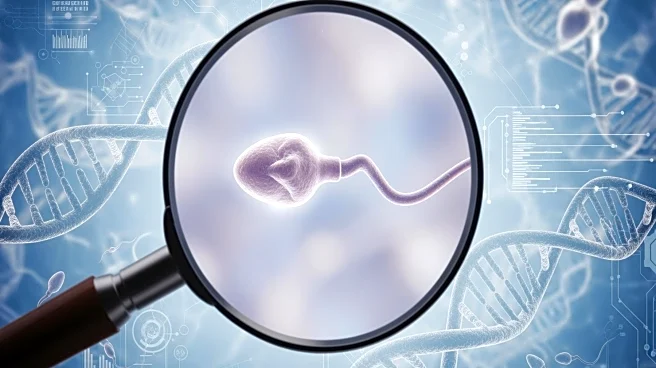What's Happening?
Recent research has uncovered that genetic mutations in sperm become more prevalent as men age, with certain DNA changes being naturally favored during sperm production. The study, published in Nature,
was conducted by scientists from the Wellcome Sanger Institute and the TwinsUK study at King's College London. They mapped harmful DNA mutations across the sperm genome of 81 healthy men aged 24 to 75, revealing that the proportion of sperm carrying disease-causing mutations increases with age. The study found that about 2% of sperm from men in their early 30s carried harmful mutations, which rose to 3-5% in men aged 43 to 74. This increase is attributed not only to random DNA errors but also to a subtle form of natural selection within the testes that favors certain mutations. The research identified 40 genes that benefit from this process, many linked to neurodevelopmental disorders and inherited cancer risks.
Why It's Important?
The findings of this study have significant implications for understanding genetic risks associated with paternal age. As the number of sperm carrying harmful mutations rises with age, there is a potential increase in the risk of passing these mutations to offspring, affecting their health outcomes. This research highlights the importance of considering paternal age in reproductive risk assessments and genetic counseling. It also opens avenues for further studies on how environmental and lifestyle factors might influence genetic health across generations. By understanding the mechanisms behind these mutations, scientists can better predict and manage the genetic risks associated with aging, potentially leading to improved reproductive health strategies.
What's Next?
Further research is needed to explore how the increasing number of sperm mutations affects children's health outcomes, including the potential for miscarriage or developmental disorders. Scientists aim to refine reproductive risk assessments and understand how genetics, lifestyle, and environment interact across generations. The study also calls for more investigations into the natural selection processes within sperm and their implications for genetic inheritance. As the research progresses, it may lead to new guidelines for reproductive health and genetic counseling, particularly for older fathers.
Beyond the Headlines
This study challenges the assumption that the germline is well-protected due to its low mutation rate. It reveals that the male germline is a dynamic environment where natural selection can favor harmful mutations, sometimes with consequences for the next generation. The research underscores the need for a deeper understanding of how genetic mutations are shaped by selection within sperm and their impact on human development and inheritance.













